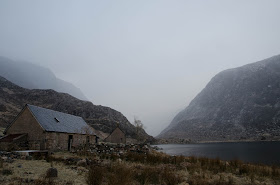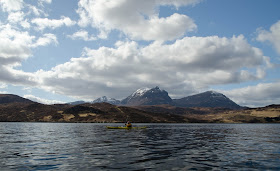I slept well in my tent, pitched behind Glendhu bothy. We woke to frozen ground and a dusting of snow which was coming and going in light showers - quite a difference to the warmth of the previous afternoon!
It's often said that in Scotland you can experience four seasons in a day - and we were about to have just such a day.
Snow was falling steadily on the hills above Glendhu. Our bothy companions took a look outside and voted unanimously for a late start to see if it would clear.
After breakfast we got packed up, said goodbye to the lads and got on the water in improving conditions. The wind died completely and the cloud began to break and lift up the crags surounding the head of the loch. An easy paced paddle took us down to Kylesku in a little over an hour.
Our plan had now evolved a little due to forecast strong winds the following day. We'd thought of shuttling a car ahead to Scourie and paddling from Kylesku north, using the camp site at Scourie, but the forecast northerlies would have made this a hard slog. Instead, we decided to drop our camping gear and excess kit at the vehicles in Kylesku, then to explore Loch a' Chairn Bhain, returning to Kylesku to finish.
On the shore opposite the fishing jetty lie the remains of the two-car ferry "Maid of Kylesku". She served the Kylesku crossing from the 1950's until 1967 when she was replaced by the "Queen of Kylesku" in 1967, which in turn was replaced by the "Maid of Glencoul". When the Kylesku bridge replaced the ferry service in 1984, the "Maid of Glencoul" was redeployed as a relief vessel at the Corran ferry in Lochaber.
"Maid of Kylesku" was simply beached when she reached the end of her service life in 1967 and it's testament to the strength of her construction that she's essentially still in one piece over fifty years later - although she has certainly seen
better days.
Having unloaded most of our kit back into the vehicles at Kylesku, wetook advantage of the strong ebb stream too pass under the Kylesku Bridge at quite a lick. Rain began to fall steadily as we set out, and soon after we went under the bridge there was a dramatic change in conditions as a squall barrelled in from the north bringing a vicious mix of rain and hail on a suddenly strong wind.
As quickly as it had come in the squall passed through and disappeared over the summit ridges of Quinag, trailing veils of rain as it did so. The wind dropped, out came the sun and it suddenly felt warm - another of Scotland's weather tricks.
By the time we reached the seaward end of Loch a' Chairn Bhain (
loch of the white cairn) we were paddling under blue skies and bright sunshine once more. I remembered a small pebble beach at the back of a tiny bay where we stopped for luncheon; there are surprisingly few landing places on the north shore of this wide loch.
The colours here were really fine, that alluring mix of white sand under turquoise water, a real treat. Allan and Lorna were both suffering from heavy colds and decided to go just a little further before turning back.......
.....but first we explored the tiny
Loch Shark, a lovely shallow loch enclosed by pine and spruce woods - most unusual for this part of the coast. As Allan and Lorna began the return leg towards Kylesku, headed north to paddle around the island of Calbha Beag (
little calf).
Almost as soon as I turned north the wind began to increase; in the channel between Calbha Mor and Calbha Beag it became a real effort to make progress and I reached the top of the island with some relief.
The north coast of this small island is rugged and steep; the wind had quickly built a swell in the wide open Eddrachilis Bay which was acting against the ebb tide to produce quite sporting conditions - lots of spray, noise and movement. I was then treated to a fast, surfing run down the west coast of the island taking advantage of the wind-over-tide wave trains....there aren't any photos of this section!
From the still frost of the early morning, to snow, dead calm, hail and rain, bright sunshine and now a barrelling wind; we'd had four seasons in a forenoon never mind a day! Truly, in Scotland we don't have a climate, we just have weather.......
I spoke to Allan on the VHF radio to let him and Lorna know I was back inside Loch a' Chairn Bhain. A pleasant paddle took me back towards Kylesku, where the bridge is suddenly revealed when a point which seems to block the loch off is rounded. This is still one of my favourite bridges, there's a simple grace to it and seen from the ridges of Quinag the curve of the deck seems to fit the landscape really well for a modern structure.
We packed up at Kylesku and consdiered options. The forecast for the following day was poor and Allan and Lorna decided to head to Scourie to camp before taking a leisurely trip home. I decided to head home to take the opportunity of seeing visiting family, and started on the journey back across country.
Before I did though, I stopped on the road at a layby with a view up the length of Loch Glencoul - a view familiar to many geology students and one that has few equals from a main road.
Heading over the watershed to the eastern side of Scotland, the higher hills were still plastered white - this is Ben Wyvis, a sprawling giant of a hill visible from a wide area.
A short trip, but a good one in a favourite part of the country; hopefully I'll be back there soon.




























































